Auxiliary drivebelt check (Every 12 000 miles (20 000 km) or 12 months)
1 Refer to the Specifications at the beginning
of this Chapter and check the tension of each
drivebelt at the point stated. Check the full
length of each drivebelt for cracks and
deterioration. It will be necessary to turn the
engine in order to check that portion of the
drivebelt in contact with the pulleys. Renew or
tension each belt as necessary as follows,
according to model type:
SOHC models
2 Note that two drivebelts are fitted to models
equipped with power steering and both
should be renewed if either one is
unserviceable. Where fitted, the air
conditioning compressor is driven by a
separate belt.
3 Disconnect the battery negative lead.
4 Where applicable, remove the air conditioning compressor drivebelt.
5 Loosen the alternator mounting and adjustment nuts and bolts, and pivot the alternator towards the cylinder block.
6 Slip the drivebelt(s) from the alternator, water pump, crankshaft and (where applicable) the power steering pump pulleys.
7 Fit the new drivebelt(s) over the pulleys, then lever the alternator away from the cylinder block until the specified belt tension is achieved. Lever the alternator using a wooden or plastic lever at the pulley end to prevent damage and straining the brackets. It is helpful to partially tighten the adjustment link bolt before tensioning the drivebelt(s).
8 Tighten the alternator mounting and adjustment nuts and bolts in the order shown (see illustration).
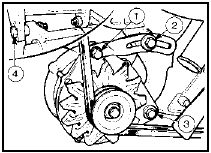
21.8 Alternator mounting tightening sequence - SOHC engines
9 Where applicable, refit and tension the air conditioning compressor drivebelt.
10 Reconnect the battery negative lead.
11 Drivebelt tension should be rechecked and if necessary adjusted after the engine has been run for a minimum of ten minutes.
DOHC models
12 Three different types of drivebelt
arrangement are used, depending on model
(see illustrations). On models without power
steering, the drivebelt is tensioned by moving
the alternator. On models with power steering,
the power steering pump is also driven by the
coolant pump/alternator drivebelt and an
automatic belt tensioner is fitted (see
illustration).
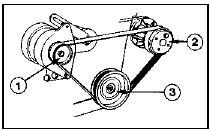
21.12a Coolant pump/alternator drivebelt arrangement - 2.0 litre DOHC engine
without power steering
1 Alternator
2 Coolant pump
3 Crankshaft pulley
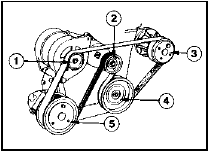
21.12b Coolant pump/alternator drivebelt arrangement - 2.0 litre DOHC engine
with power steering
1 Alternator
2 Automatic belt tension
3 Coolant pump
4 Crankshaft pulley
5 Power steering pump
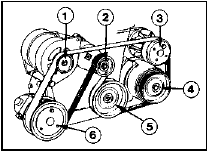
21.12c Coolant pump/alternator drivebelt arrangement - 2.0 litre DOHC engine
with power steering and air conditioning
1 Alternator
2 Automatic belt tensioner
3 Coolant pump
4 Air conditioning compressor
5 Crankshaft pulley
6 Power steering pump
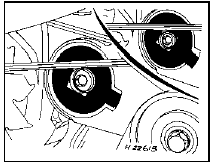
21.12d Alternator/coolant pump drivebelt tensioner indicator position - 2.0
litre DOHC engine
Inset shows tensioner at maximum adjustment
On models with air conditioning, the drivebelt drives the alternator, coolant pump, power steering pump and air conditioning compressor, and an automatic belt tensioner is fitted.
13 On models without power steering, loosen the alternator mounting and adjustment bolts, and pivot the alternator towards the cylinder block. Slip the drivebelt from the pulleys.
14 On models with power steering, the automatic tensioner can be released using a 17 mm socket and a wrench on the boss in the centre of the pulley. Lever the tensioner assembly clockwise, slide the belt from the pulleys, then slowly release the tensioner.
15 To fit a new belt on models without power steering, slide the belt over the pulleys, then lever the alternator away from the cylinder block until the correct belt tension is achieved. Lever the alternator using a plastic or wooden lever at the pulley end to prevent damage. It is helpful to partially tighten the adjustment link bolt before tensioning the drivebelt. When the correct tension is achieved, tighten all the bolts.
16 To fit a new belt on models with power steering, lever the tensioner clockwise as during removal, then slide the belt over the pulleys, and slowly release the tensioner.
See also:
Engine electrical systems
General information and precautions
General information
The electrical system is of the 12 volt
negative earth type, and consists of a 12 volt
battery, alternator with integral voltage
regulator, ...
Steering column - removal, overhaul and refitting
Removal
1 Disconnect the battery negative terminal.
2 Turn the ignition key and rotate the steering
wheel to bring the front roadwheels to the
straight-ahead position.
3 Working within the engine ...
Engine dismantling, examination, renovation and reassembly - general
information
Dismantling
1 It is best to mount the engine on a
dismantling stand but if this is not available,
stand the engine on a strong bench at a
comfortable working height. Failing this, it will
have to ...
